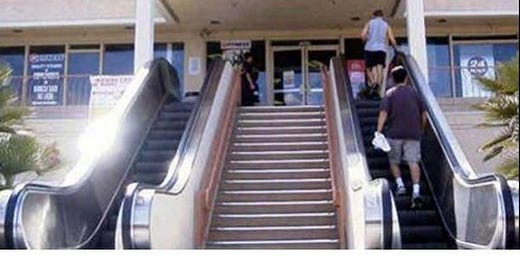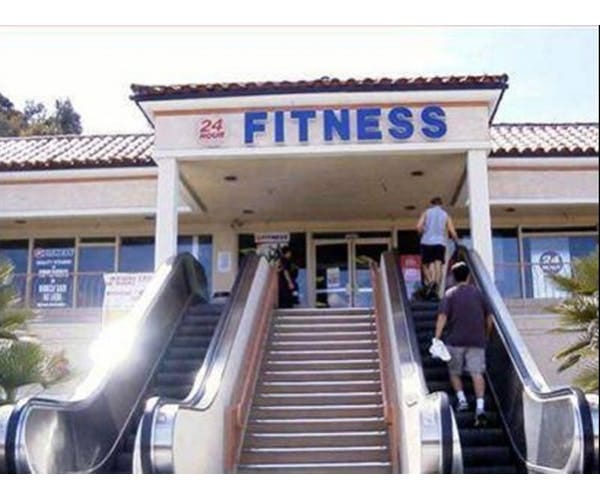4 Ways to Make Exercise Great Again
Our fitness changed for the worst once we adopted gym culture. Here's how we can take it back.
I was in Los Angeles getting a tattoo last week from my friend Scott, who does the most interesting work ever (related: sorry, Mom). We got on the topic of fitness, and I told him about a photo that I think encapsulates how society views physical activity today.
Exhibit A: People avoiding climbing stairs and walking while on their way to … climb stairs or walk on a machine.
Today’s 2% Newsletter is a bit of a think piece about modern physical activity and four ways we can make it better.
The Invention of Exercise
“Exercise”—physical activity for the sake of it—is a very new concept. It took off after the post-World War II technological revolution. This is when new machines spread widely and began removing physical activity from our home and work life. The examples are endless, but to name a few: washing machines saved us from scrubbing, telephones saved us from walking down to the neighbor’s, pre-made staple foods saved us from grinding wheat (grinding wheat was a daily, back-breaking chore for about 20 percent of Americans up until about 1900). Desk work became more common, and even blue-collar jobs became less active. Etc, etc, etc.
Not coincidentally, this is when chronic diseases like heart disease became more common. We realized our new lack of physical activity probably had something to do with that.
So to maintain our health, we began offsetting our lost movement with exercise. We often did this inside hermetic gyms where we could control exactly how we would like to be physically active.
Soon we could watch TV while running at a predetermined incline and speed along a motorized belt. Or we could lift preselected weights that were perfectly balanced or attached to a machine where we sit on a padded seat, resting our joints against another pad, and move handles along a fixed movement path. We would quit when we felt like it. And this was all happening in a temperature-controlled building divorced from the rest of our life.
What’s more, we could pick one physical skill and chase it at the expense of others. We could build muscle for the sake of it. Or we could run and rarely use our strength. Or we could get really good at bending ourselves into awkward positions.
Physical Activity of the Past
Physical activity was much more dynamic for about 99.99 percent of human lineage. It was forced and unpredictable. We didn’t get to choose how we were active. We did what our environment asked of us to survive. Take hunting: We’d run as far and fast as we needed to kill an animal. Could be three miles. Could be thirteen. And then we’d have to carry the meat back an equal distance back to camp. When we’d gather food, we didn’t get to choose how far we’d have to walk or deep we’d dig. These acts required many physical skills—speed, strength, mobility, power, endurance, etc. If we built up one skill at the expense of others, we’d put ourselves at a disadvantage.
And this all occurred outdoors over rough terrain while exposed to the elements. A scientist at USC told me that running or walking on a trail may improve brain health to a greater degree. We have to make decisions about navigation, pacing, encountering obstacles, and more. This adds a cognitive challenge to the activity that we don’t get in a gym, he told me.
Modern exercise is good! It’s the result of progress. I’d much rather have to choose to exercise than be forced to for survival.
But I do think we’re still in a phase of figuring out what exercising for ideal physical and mental health looks like. I also think we lose something by only exercising indoors—separating exercise from our lives and making it hyper-specific.
How to Make Exercise Great Again
It’s worth exploring how we can put ourselves back into positions where activity is forced, a bit less predictable, and where we have to use many physical skills. So how do you do that? First, be a 2-Percenter. Figure out how to make your everyday life more physically challenging. But when it comes to exercise, the time you set aside for physical activity, here are some general guidelines:
Make exercise unpredictable
Exercise outdoors more often
Use multiple skills at one
Put yourself in positions where you can’t quit
So how do you do all that? It takes a bit of creativity.
For example, something as simple as a run or ruck on a trail presents much more variability and unpredictability. The trail isn’t perfectly flat and has many more ups and downs, rocks, and ruts. The weather won’t be a perfect 72 degrees. And if you decide to quit, you still have to turn around and make it home.
Or you could ruck to a playground or field near your home then invent a workout with what you can find once you get there. Or it could be that you go for a hike, notice a log at the side of the trail, and decide to carry it for a while. Yes, this is a strange thing to make up. But it’s far less odd in the grand scheme of time than running on a treadmill or using a weight machine.
Even better: Do all of these things with other people. In the past, we physically worked together. But gym exercise can often become a solitary act, with everyone in their own world behind headphones. For men, F3 is a great movement to find people to exercise outdoors with for free. GORUCK also has ruck clubs across the country. There are many other options.
Weaving together different research in neuroscience, physiology, psychology, and more suggests that this approach is an important addition to our lives. That isn’t to say you should avoid the gym if you enjoy it. Not at all. I have a gym in my garage and use it all the time. But we should think of creative ways to put ourselves in positions where we can’t easily quit and where exercise isn’t as predictable and sanitized.
2% Top Two
My two favorite things this week:
One: Sandlot JAX
GORUCK is holding their second annual Sandlot JAX festival. It's an incredible event that celebrates physical and mental health. Think: The Woodstock of health and fitness. There are plenty of physical events, but I'll be leading the intellectual side of it, TED-style talks on new ideas in the space. I'll even give a talk of my own. Dates are April 21-23.
Two: Jerry Garcia on Living in the Exploding Moment
I referenced this story when I appeared on Peter Attia's The Drive podcast. I finally found the clip on YouTube! This clip altered how I think about writing and creativity. Two key quotes:
"For me, it was important to be involved in something that was flowing and dynamic and not so solid that you couldn't tear it down."
"In eternity, nothing will be remembered of you ... you're there in the exploding moment. So, yeah, let's have some fun."
Thanks for reading. Have some fun and I'll see you next week,
Michael
Sponsored by GORUCK
When I decided to accept sponsorships for this newsletter, GORUCK was a natural fit. Not only is the company's story included in The Comfort Crisis, but I've been using GORUCK's gear since the brand was founded. Seriously. They've been around ~12 years and I still regularly use a pack of theirs that is 11 years old. Their gear is made in the USA by former Special Forces soldiers. They make my favorite rucking setup: A Rucker and Ruck Plate.




